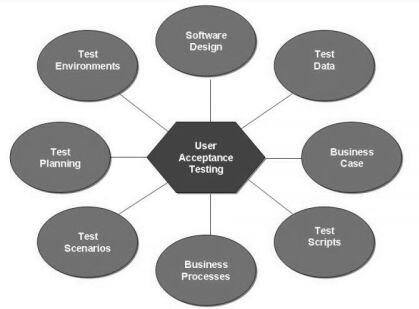What is User Acceptance Testing
In this type of testing, the software is handed over to the user in order to find out if the software meets the user expectations and works as it is expected to. In software development, user acceptance testing (UAT) – also called beta testing, application testing, and end user testing – is a phase of software development in which the software is tested in the “real world” by the intended audience. View the pdf tutorials about UAT
User Acceptance Testing can be done by in-house testing in which volunteers or paid test subjects use the software or, more typically for widely-distributed software, by making the test version available for downloading and free trial over the Web. The experiences of the early users are forwarded back to the developers who make final changes before releasing the software commercially.

The popular technology encyclopedia, Technopedia: “User acceptance testing (UAT) is the last phase of the software testing process. During UAT, actual software users test the software to make sure it can handle required tasks in real-world scenarios, according to specifications. UAT is one of the final and critical software project procedures that must occur before newly developed software is rolled out to the market.”
User acceptance testing also goes by other nomenclature such as End-user testing, Application, or Beta and is usually the last stage during the process of designing a website before the software is finally distributed or installed on the system of the client.
This is done by selecting some people from the potential users of the software and asking them to use the software before it is finally released for use. While using the software, these selected users will take note of the flaws in the software for further modification and correction before the final release. This affords the users the opportunity to interact well with the software and see what the features are and which of the features are absent or malfunctioning. They also pay attention to sections of the software that are disconnected from the others and may lead to a lack of meaningful communication between the different sections of the software.
Types of User Acceptance Testing
User Acceptance Testing is divided into the following types:
- Black Box Testing
In this testing, the tester doesn’t bother himself with the features of the application but tests whether the software meets its purpose. In essence, some functionalities of the software will be tested.
- Alpha & Beta Testing.
This is also called Field Testing and takes place in the customer’s environment. This is specifically testing the software extensively by a couple of customers who use the software in their environment. After the testing, they will provide feedback that will be used to improve the product.
- Regulation Acceptance Testing
The software is checked against some regulations such as legal and governmental regulation to determine whether it meets those regulations. This is also known as Compliance Acceptance Testing.
- Contract Acceptance Testing
This testing is carried out to determine whether the designed software meets some specifications and criteria which are specified and agreed upon before the development of the software.
- Operational Acceptance Testing
This testing is used to determine the operational readiness or pre-release of a system, service, or product as an important aspect of a quality management system.
How to perform in-house User Acceptance Testing
Sometimes, there may be the need for in-house testing of a software program. These are the simple steps to take for testing:
- Planning: While planning, the UAT strategy is explicitly outlined.
- Designing test cases: In order to cover all the areas where the software will be used in real life, test cases are designed
- Selection of the testing team. This team will be made up of real users.
Why is User Acceptance Testing Necessary?
You may be wondering why a company will go through the process of repeatedly testing a product before it is distributed for general consumption. Here are a few reasons why the testing is necessary:
- User requirements are captured in a verifiable way.
- They help the developers identify the potential problems the software will have in the future.
- It is a good assessment of how ready for use the system is.
If you have a system designed for public consumption, you will not want to avoid the user acceptance testing. It is the only way to ensure the efficiency of your system.
